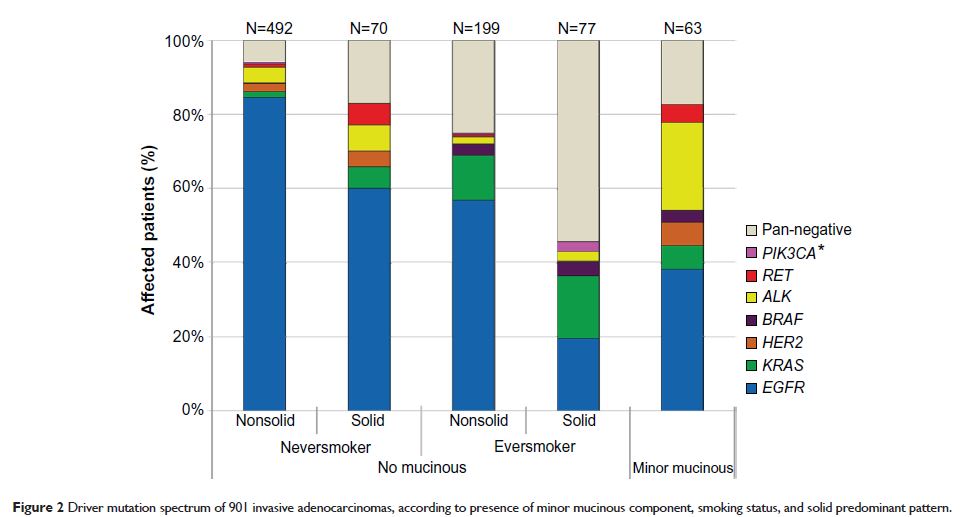9 0 6 7 6
论文已发表
注册即可获取德孚的最新动态
IF 收录期刊
- 2.6 Breast Cancer (Dove Med Press)
- 3.9 Clin Epidemiol
- 3.3 Cancer Manag Res
- 3.9 Infect Drug Resist
- 3.6 Clin Interv Aging
- 4.8 Drug Des Dev Ther
- 2.8 Int J Chronic Obstr
- 8.0 Int J Nanomed
- 2.3 Int J Women's Health
- 3.2 Neuropsych Dis Treat
- 4.0 OncoTargets Ther
- 2.2 Patient Prefer Adher
- 2.8 Ther Clin Risk Manag
- 2.7 J Pain Res
- 3.3 Diabet Metab Synd Ob
- 4.3 Psychol Res Behav Ma
- 3.4 Nat Sci Sleep
- 1.9 Pharmgenomics Pers Med
- 3.5 Risk Manag Healthc Policy
- 4.5 J Inflamm Res
- 2.3 Int J Gen Med
- 4.1 J Hepatocell Carcinoma
- 3.2 J Asthma Allergy
- 2.3 Clin Cosmet Investig Dermatol
- 3.3 J Multidiscip Healthc

已发表论文
肺腺癌致癌突变与病理类型有关,但无独立的预后价值
Authors Hu H, Pan Y, Li Y, Wang L, Wang R, Zhang Y, Li H, Ye T, Zhang Y, Luo X, Shao L, Sun Z, Cai D, Xu J, Lu Q, Deng Y, Shen L, Ji H, Sun Y, Chen H
Published Date August 2014 Volume 2014:7 Pages 1423—1437
DOI http://dx.doi.org/10.2147/OTT.S58900
Received 8 December 2013, Accepted 23 April 2014, Published 13 August 2014
Abstract: Lung adenocarcinomas have diverse genetic and morphological backgrounds and are usually classified according to their distinct oncogenic mutations (or so-called driver mutations) and histological subtypes (the de novo classification proposed by the International Association for the Study of Lung Cancer/American Thoracic Society/European Respiratory Society [IASLC/ATS/ERS]). Although both these classifications are essential for personalized treatment, their integrated clinical effect remains unclear. Therefore, we analyzed 981 lung adenocarcinomas to detect the potential correlation and combined effect of oncogenic mutations and histological subtype on prognosis. Analysis for oncogenic mutations included the direct sequencing of EGFR , KRAS , HER2 , BRAF , PIK3CA , ALK , and RET for oncogenic mutations/rearrangements, and a rereview of the IASLC/ATS/ERS classification was undertaken. Eligible tumors included 13 atypical adenomatous hyperplasia/adenocarcinoma in situ, 20 minimally invasive adenocarcinomas, 901 invasive adenocarcinomas, 44 invasive mucinous adenocarcinomas, and three other variants. The invasive mucinous adenocarcinomas had a lower prevalence of EGFR mutations but a higher prevalence of KRAS , ALK , and HER2 mutations than invasive adenocarcinomas. Smoking, a solid predominant pattern, and a mucinous component were independently associated with fewer EGFR mutations. The ALK rearrangements were more frequently observed in tumors with a minor mucinous component, while the KRAS mutations were more prevalent in smokers. In addition, 503 patients with stage I–IIIA tumors were analyzed for overall survival (OS) and relapse-free survival. The stage and histological pattern were independent predictors of relapse-free survival, and the pathological stage was the only independent predictor for the OS. Although patients with the EGFR mutations had better OS than those without the mutations, no oncogenic mutation was an independent predictor of survival. Oncogenic mutations were associated with the novel IASLC/ATS/ERS classification, which facilitates a morphology-based mutational analysis strategy. The combination of these two classifications might not increase the prognostic ability, but it provides essential information for personalized treatment.
Keywords: oncogenic mutation, IASLC/ATS/ERS classification, personalized treatment, molecular testing, prognosis
Keywords: oncogenic mutation, IASLC/ATS/ERS classification, personalized treatment, molecular testing, prognosis
